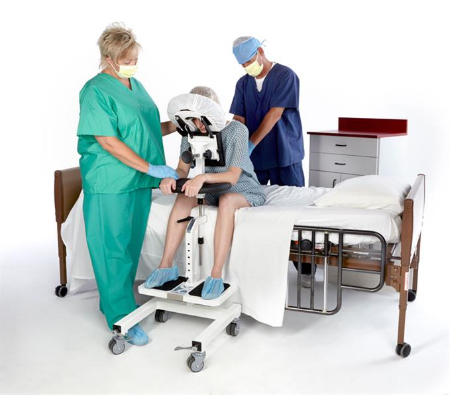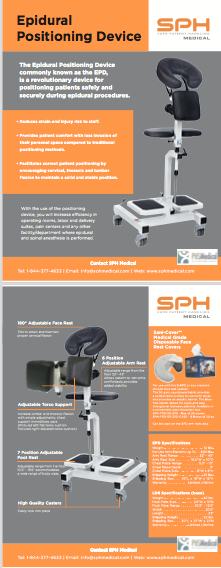
The Epidural Positioning Device
Almost two decades ago a leading anesthesiologist developed the first Epidural Positioning Device to help improve patient and staff safety. And now the EPD is the gold standard of positioning devices for use by hospital and surgical staff around the world. Visit the EPD product page to order now!
Reduce the risk of caregiver injury – Eliminate Manual Handling
Manual patient handling puts our nursing staff at risk of musculoskeletal injuries. In the peri-operative areas of Pre-Op, OR, L&D, L&D Or, and throughout the hospital staff are holding patients in position during epidural and spinal block placements. The most common scenario we hear is this: The patient is sitting at bedside and a movable stool on wheels is moved over to the patient so their feet can rest on the stool. The nurse brings a bedside table (that doesn’t lock) over to the patient and stacks it with pillows to have the patient lean over onto the table to create the “mad cat” flexed spine position. Or in some cases the patient is just leaning forward over a stack of pillows in front of them. The nurse then uses his or her knees or thighs to hold the footstool in place and somehow keep the patients upper body in a static position. The nurse or nurse assistant often has to hold the patient in position supporting some of their body weight to prevent any movement during needle placement. To complicate this situation, patients are nervous, unpredictable, often in pain, sometimes sedated, and may move suddenly putting the nurse at further risk. Leading hospital ergonomic teams have identified these prolonged static holds and counter pressure tasks as high risk and given their predictable daily routine have looked to redesign the process for Epidural and Spinal Block Placement to remove the manual patient handling components. Epidural Positioning Device was designed to solve these issues reducing risk to caregivers while increasing patient comfort and patient safety by creating an ideal position for needle placement.
Manual Patient Handling causes caregiver injuries even when “normal” patients are being handled manually. It is the cumulative nature of lifting, pushing, pulling, holding, catching, tugging, boosting, turning and transferring that causes micro tears in the vertebral discs and joints that over time lead to injury. We need to modify the way we handle patients to avoid manual handling at all costs especially when the task is predictable.
The old fashioned way we used to do it before EPD


Patient Positioning Challenges
Here are some of the challenging situations and safety risks that staff face in the Labor and Delivery unit, pre-op, OR, Outpatient Surgery, and pain clinics during epidural and spinal block placements.
- Holding patient in position – static holds – staff safety risk
- Non-locking tables – patient safety risk
- Stacking pillows on the non locking tables – patient safety risk
- Medicated patients may not be able to hold the proper position
- Trying to hold a stool in position while supporting a patient
- Patients of size may require multiple staff members to hold in position
- Patients may react unexpectedly and attempt to move
- Patients may feel dizzy or nauseous and which may result in movement
- Patients may not be able to follow instructions and try to change position
- Patients may be nervous and combative and have bitten staff members!
- When patients are difficult to position it takes more time!
Now with the EPD! The patient is safe, secure, and in the correct position. The flexibility of the EPD to adapt to your patient population is a key part of it’s success. The nurses are adjusting the EPD to suit their needs and loving it!
Some of our leading hospital customers and health systems have standardized on the EPD include Duke University Hospital, John’s Hopkins, UCLA Medical Center, Kaiser Hospitals, University of Virginia Medical Center, VA Medical Centers, and many more.
New Safe Patient Handling Guidelines published by AORN in 2019 recommend reducing manual patient handling throughout all Peri-Operative areas. This focus on safety includes more than patient transfers and strives to reduce risk of injury to staff from prolonged static holding and positioning of patients. This should include all tasks related to anesthesia and pre-op Spinal Blocks and Epidural Placements. SPH Medical is taking lead on presenting EPD solutions to leading healthcare systems to support this same initiative. In 2020 we are working to help the VA Healthcare System and many other large regional and national health care systems implement new standards of care for these areas. The EPD or Epidural Positioning Device (sometimes called the Epidural Positioning Chair) is the simplest of tools that is rapid and easy to implement and make a significant impact on staff and patient safety.
Patient Satisfaction and Comfort increases with the Epidural Positioning Device
A new study has shown that for pregnant women receiving an epidural, patient comfort was significantly higher with use of the EPD versus flexion alone. It was also concluded that greater patient comfort might facilitate needle placement. See Efficacy of the Epidural Positioning Device® in optimizing the acoustic target window for neuraxial needle placement in term pregnancy”. We’re excited to have this new research available as it confirms that hospitals are seeing patient satisfaction increasing with the use of EPD.
A recent evaluation by the clinical team at Unity Point Health in Grinnell Iowa provided the following positive feedback about the value of the EPD:
- The EPD is used throughout the facility where Epidurals and Spinal Blocks are occurring, L&D, OR and more
- Nursing staff like the adjustability of the EPD to accomodate a wide range of patient body types
- The EPD frees up nursing staff to do other important tasks
- The EPD’s ability to handle our bariatric population of 300 lb + patients is a key benefit
- We find that the EPD is helpful for use with multiple patient diagnoses
Laura Juel RN, MSN
- Vice President, Nursing & Clinical Services
- UnityPoint Health- Grinnell, IA
Here are the specs for the EPD (Upper section only):
- The freestanding weight of the EPD is 12 lbs
- Total maximum weight capacity is up to 600 lbs
- The range for the Arm Rests is 32″ – 43″
- Dimensions of the Arm Rests are 16.5” x 10”
- The Telescoping arm for the Chest Pad extends between 5.5” and 10”
- The dept of the chest piece is 3”
- Plate supporting the Chest piece measures 8” x 8”
- When Shipping The EPD Section the shipping weight is 42 lbs
- The dimensions of the shipping Box for the EPD (upper section only) is 32” x 18” x 15”
The specs for the LDS base of the EPD are as follows:
- Total Weight of the base which includes wheels footplate and legs is 42 lbs
- The measurements of the Foot Plate are 20” x 12”/li>
- The foot plate can be adjusted between 10.5” x 19.5”/li>
- The overall width of the LDS base is 20.5″/li>
- And the overall length of the LDS base is 23″/li>
- When packaged the overall dimensions of the shipping box are 29” x 26” x 21”/li>
- The total weight for shipping is 50 lbs/li>
Here are additional specs for the EPD and LDS Base:
-
- The total weight of the EPD and LDS Base when assembled is 54 lbs
- The EPD has a adjustable range in height of 50″- 60″
- The clearance of the floor to the top of the base is 5″
- The measurement between the foot pedals/brakes is 10″
SPH Medical is the authorized national distributor for Pivotal Health’s industry leading line of EPD’s. Contact SPH Medical to request more information or to request a quotation.
Visit our Our EPD Resource page for more information.




